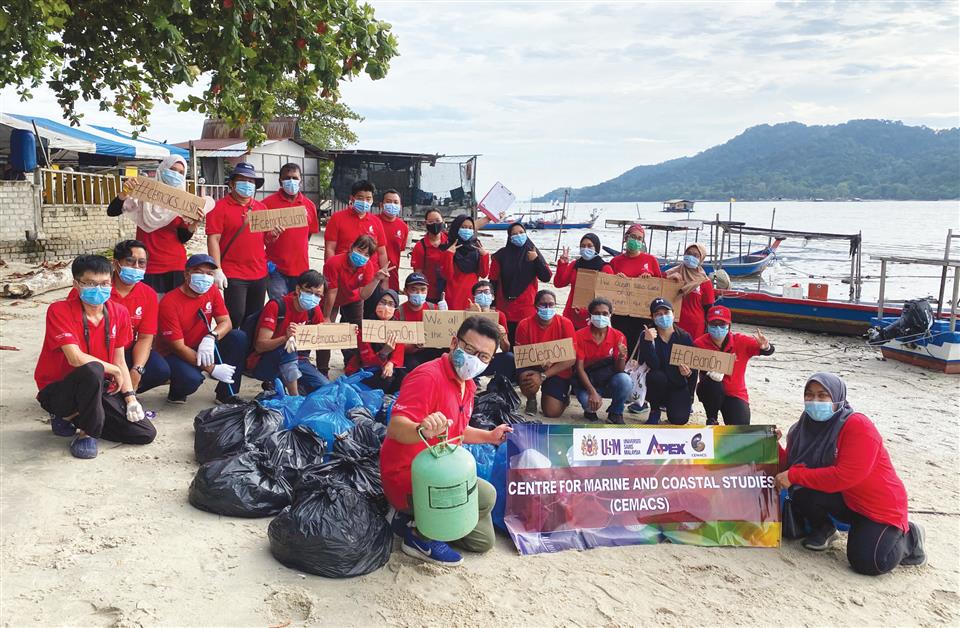CEMACS’ Coastal Cleanup Month Nets Cigarette Butts, Face Masks and Gloves

TAKE A LONG leisurely walk along Penang’s beaches. What do you see? Iterations of clustered seashells dotting their lengths perhaps, but among them as well are pieces of plastic and trash. These are ubiquitous and contribute to a much larger problem: marine debris, or solid materials of human origin that are discarded at sea, or that reach the sea through waterways or as domestic and industrial outfalls1.
Put plainly, marine debris poisons sea life, often through accidental ingestion of plastic pieces. While floating debris and fishing nets entangle and ensnare aquatic life, much more worrying, however, is the presence of microplastics. Studies are discovering that microplastics can be found in the most unlikely things today, e.g. salt, laundry, make-up, and even tea bags.2 Reports are also warning us that microplastic fibres are now in the air we breathe!3
Plastic pollution is practically a pandemic now, and there is definitely cause for alarm.
Celebrating International Coastal Cleanup Day
Observed annually on every third Saturday of September, the International Coastal Cleanup Day this year fell on September 19. But in view of the pandemic, Universiti Sains Malaysia’s Centre for Marine and Coastal Studies (CEMACS) decided to commemorate the occasion with a slight twist – by encouraging people to conduct their own beach cleanups instead, in small groups, wherever they liked and at their convenience for an entire month, from September 19 to October 18.
CEMACS kicked off the month-long cleanup along Medan Selera Queensbay (Pantai Seagate). A total of 166kg of trash was collected on a 930m stretch of beach. Of the items gathered, cigarette butts numbered the most, followed by plastic grocery bags and straws/stirrers.
The team also audited the weight and type of trash collected. Participants were likewise urged to do their own trash audit and to submit their data on CEMACS’ online form. The results were most encouraging. Data was received from the twelve groups that were formed in response – seven in Penang, three in Kelantan, and one each in Pulau Langkawi and Kuching4. The collective cleanup yielded 7,347 trash items from different coastal areas.
Based on the overall data, discarded cigarette butts were again the most pervasive item, at 1,166 pieces. Here’s an interesting fact about cigarette butts – their filters actually contain plastic fibres made from cellulose acetate. Irresponsible littering of these therefore contributes to plastic pollution since they take years to degrade, and when they do, they leave behind microplastics. On top of that, cigarette butts harm the environment by leaching out chemicals and heavy metals5. This certainly is a global problem, and one that requires the mindful cooperation of smokers in discarding their waste as safely as possible.
The coronavirus pandemic also saw a meteoric rise in single-use plastics, most notably in food take-aways and protective gears. During CEMACS’ beach cleanup, 115 disposable face masks, 49 gloves and 6 plastic face shields were picked up. Responsible disposable of these waste materials is not being practised. The two most effective suggestions are the following: i) cut off the ear loops from the disposable face mask before discarding it or ii) to use a cloth face mask instead. The former is to avoid harm to wildlife. A young seagull made headlines last July when its legs got entangled in the ear loops of a face mask, causing its limbs and joints to swell.
These are just some small, but significant ways through which humans can show some responsibility for their waste. CEMACS has taken a pledge to connect with the public to heighten awareness of the severity of plastic pollution and to heed the call of the UN’s Sustainable Development Goal 14: Life below water.
We wish to thank the volunteers who took the time and effort to participate in CEMACS’ month-long coastal cleanup activities. We hope that our initiative will continue to create awareness. If you are keen to collaborate on environmental and educational activities, visit our Facebook @cemacsUSM or Instagram @cemacs_usm.
References
1 National Academy of Sciences (1975) Marine litter. In: Assessing potential ocean pollutants. A report of the study panel on assessing potential ocean pollutants to the Ocean Affairs Board, Commission on Natural Resources, National Research Council, National Academy of Sciences, Washington D.C.
2 https://oceanconservancy.org/trash-free-seas/
3 Johnny Gasperi, Stephanie L. Wright, Rachid Dris, France Collard, Corinne Mandin, et al. Microplastics in air: Are we breathing it in? Current Opinion in Environmental Science & Health, 2018, 1, pp.1 - 5. ff10.1016/j.coesh.2017.10.002ff. ffhal-01665768f
4 Complete trash collection data: https://www.facebook.com/cemacsUSM
5 https://www.nationalgeographic.com/environment/2019/08/cigarettes-story-of-plastic
By Dr. Annette Jaya Ram and Dr. Abe Woo Sau Pinn (Centre for Marine and Coastal Studies, Universiti Sains Malaysia)
December, 2020
- Hits: 1527